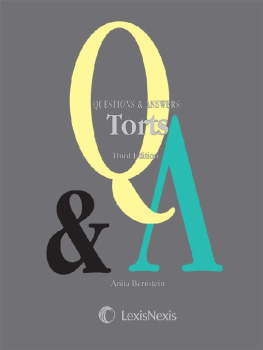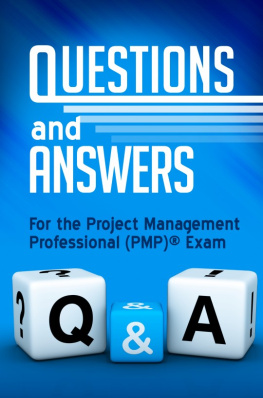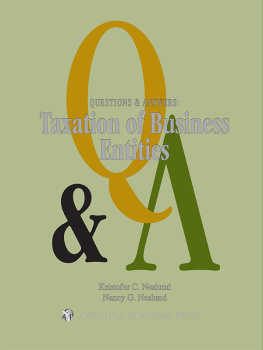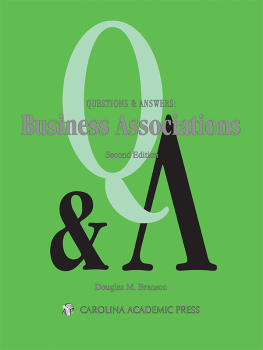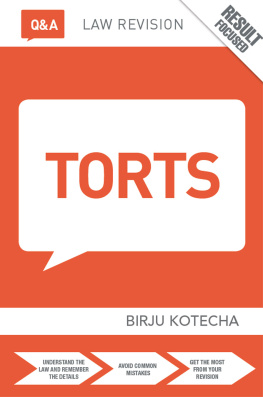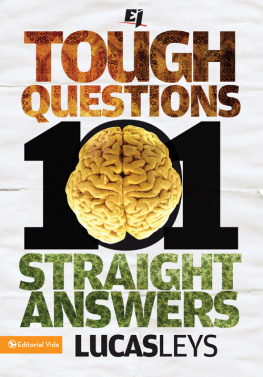Questions & Answers :
TORTS
LexisNexis Law School Publishing
Advisory Board
Paul Caron
Professor of Law
Pepperdine University School of Law
Herzog Summer Visiting Professor in Taxation
University of San Diego School of Law
Bridgette Carr
Clinical Professor of Law
University of Michigan Law School
Olympia Duhart
Professor of Law and Director of Lawyering Skills & Values Program
Nova Southeastern University, Shepard Broad Law School
Samuel Estreicher
Dwight D. Opperman Professor of Law
Director, Center for Labor and Employment Law
NYU School of Law
Steven I. Friedland
Professor of Law and Senior Scholar
Elon University School of Law
Carole Goldberg
Jonathan D. Varat Distinguished Professor of Law
UCLA School of Law
Oliver Goodenough
Professor of Law
Vermont Law School
Paul Marcus
Haynes Professor of Law
William and Mary Law School
John Sprankling
Distinguished Professor of Law
McGeorge School of Law
[i/ii]
Questions & Answers:
TORTS
Third Edition
Multiple Choice, Short Answers,
Essay Issue-Spotters, and
90-Minute Practice Final Exam
ANITA BERNSTEINAnita and Stuart Subotnick Professor of Law
Brooklyn Law School
[ii/iii]
ISBN: 978-0-7698-8190-4 (print)
ISBN: 978-0-7698-8192-8 (eBook)
This publication is designed to provide authoritative information in regard to the subject matter covered. It is sold with the understanding that the publisher is not engaged in rendering legal, accounting, or other professional services. If legal advice or other expert assistance is required, the services of a competent professional should be sought.
LexisNexis and the Knowledge Burst logo are registered trademarks of Reed Elsevier Properties Inc., used under license. Matthew Bender and the Matthew Bender Flame Design are registered trademarks of Matthew Bender Properties Inc.
Copyright 2014 Matthew Bender & Company, Inc., a member of LexisNexis.
All Rights Reserved.
No copyright is claimed by LexisNexis or Matthew Bender & Company, Inc., in the text of statutes, regulations, and excerpts from court opinions quoted within this work. Permission to copy material may be licensed for a fee from the Copyright Clearance Center, 222 Rosewood Drive, Danvers, Mass. 01923, telephone (978) 750-8400.
NOTE TO USERS
To ensure that you are using the latest materials available in this area, please be sure to periodically check the LexisNexis Law School web site for downloadable updates and supplements at www.lexisnexis.com/lawschool.
Editorial Offices
121 Chanlon Rd., New Providence, NJ 07974 (908) 464-6800
201 Mission St., San Francisco, CA 94105-1831 (415) 908-3200
www.lexisnexis.com
Terms of Use
Your use of this electronic publication (eBook) from LexisNexis, a division of Reed Elsevier Inc., a Massachusetts corporation, is subject to the following terms and conditions. This eBook is for your personal use only. All access to and use of this eBook is subject to U.S. and international copyright law. All intellectual property rights are reserved to the copyright holder. Redistribution or duplication of this eBook to any other electronic media or a third party is strictly prohibited. Under no circumstances may you redistribute this eBook commercially or post this eBook on an intranet, internet or SharePoint site. Finally, use of this eBook is further subject to the terms and conditions of use which were accepted at the time you completed your purchase of this eBook from the point of purchase.
Hyperlink Key
In order to distinguish between the links to other sections within LexisNexis eBooks and external links to the Internet, we have added color coding to the links.
Following is a color key for the links:
Blue: Links inside the eBook
Green: External links to LexisNexison-line and the Internet
[iii/iv]
In memory of David P. Leonard
19522010
[v/vi]
The law of torts deals with an extremely broad range of human conduct. From punches in the nose to automobile accidents; from affronts to dignity to environmental pollution; from defective products to fraud. Not only must rules of tort law regulate vastly different types of potentially harmful behavior, but they must also be flexible enough to account for the almost limitless variety of fact patterns within each type. No two punches in the nose are exactly alike. And yet, the rules must be fashioned in such a way as to make the law at least reasonably predictable and the results of the cases both fair to individuals and conducive to social prosperity.
For these reasons, modern rules of tort law are written in broad strokes. They seldom seek to prescribe specific behavior in specific circumstances (always stop, look, and listen before crossing a railroad track). Rather, they set forth general principles to guide behavior in a variety of circumstances (always exercise reasonable care). Instead of purporting to tell us exactly what to do, they provide us with standards against which our conduct may be measured.
The generality of tort rules is what makes the study of tort law difficult. But tort is not unstructured. Every claim for relief and every affirmative defense has a set of required elements. These elements tell lawyers what they must allege and prove in order to demonstrate their clients entitlement to relief or why their clients should not be held responsible. It is your task to learn what these elements are and how to apply them to real and hypothetical fact patterns.
How can Questions and Answers: Torts help you in this task? Recognizing that torts coverage varies somewhat from school to school, instructor to instructor, and even day to day in the same course, this book follows a comparably varied path to give you what you need.
You will find a range of difficulty. Some questions are tough while others are pretty easy. A panel of second-year students who completed Torts successfully have assigned the Easy, Medium, and Hard ratings that you will find under Answers. To maximize the value of these rankings, the questions appear in the order of Easy Medium Hard with two exceptions: First, when a scenario yields more than one question you might find a harder question followed by an easier one. Second, the difficulty order on the Practice Final Exam is (purposely) random.
Multiple choice questions, which predominate in this book, always offer four alternatives and only rarely resort to something like none of the above. They might ask you to pick the best of a list, the worst of a list, the correct one of two contrary outcomes accompanied by the best rationale, or the story that illustrates a point of doctrine most effectively, as well as other routes to mastery of the material. Short-answer questions ask you to analyze scenarios or communicate discrete points. A little (simple) arithmetic comes up now and then just as it does for practicing lawyers. The Practice Final Exam simulates reality by not announcing up-front, the way the chapter headings do, which topics are being tested. Whether youre in your beginning or ending stage of pulling torts material together then, youll find coverage at a useful level.

